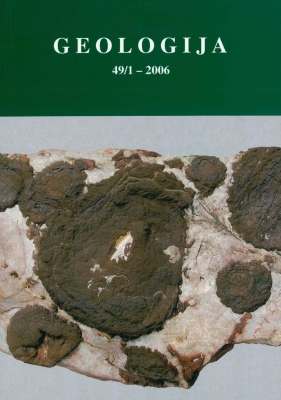Application of a perialpine landslide susceptibility model in the Alpine region (Slovenia)
DOI:
https://doi.org/10.5474/geologija.2006.012Abstract
A very good landslide susceptibility prediction model was developed for the area in the perialpine region in the central western Slovenia. Using multivariate statistics the interactions between spatial factors and landslide distribution were tested, and the importance of individual factor to the landslide susceptibility was defined. On the basis of the statistical results several landslide prediction models were developed using the Analytical Hierarchy Process (AHP) method. These models gave very different results, with a prediction error ranging from 6,89 % to 31,8 %. As a final result of the research, weights of different spatial factors from the best models calculated with the AHP method were derived. The results showed that the lithology (31 % variance), the slope inclination (21,2 % variance), land cover type (13,7 % variance), the terrain roughness (10,1 % variance), and the terrain curvature (8,6 % variance) play an important role in landslide susceptibility in general. Minor roles also play the distance to streams and the distance to structural elements. These factors weights values were later used as input values in a simple linear weighted landslide susceptibility prediction model for the area in the Alpine region (north-western Slovenia). The fact is that the ideal weight’s value of a factor differs from area to area. Each original weight value used in the new (Alpine) model presented only the mean of the new weight’s range/distribution, which was used as an input to the linear model. The analysis of the ideal factors weights in the Alpine area included several analytical trials, where different factors with different weight distribution were used. Altogether, almost 65 000 different models were calculated and tested to the landslide distribution. The best prediction results gave the model, where lithology played the major role in the landslide susceptibility (30 %), slope inclination contributed less (22 %), and land cover type contributed 20 % to the landslide susceptibility. The terrain curvature contributed 16 % to the landslide susceptibility. The distance to streams 10 % and the distance to structural elements contributed 2 % to the landslide susceptibility. When the importance of the synchronism of strata dipping and slope aspect was tested, this factor showed to be very significant (18 % - 22 %). The application of calculated weights from one area into another showed that general principles of spatial factor significance do exist, although they differ in some extent. This proof could be effectively used for fast and relatively inexpensive assessments of landslide susceptibility predictions in the remote and inaccessible regions such as are Alpine areas, but one should always bear in mind that some site specific spatial factors, i.e. synchronism of strata dipping and slope aspect, also play an important role in the landslide susceptibility, especially in the steep areas.Downloads
How to Cite
Komac, M. (2006). Application of a perialpine landslide susceptibility model in the Alpine region (Slovenia) . Geologija, 49(1), 141–150. https://doi.org/10.5474/geologija.2006.012
Issue
Section
Articles

